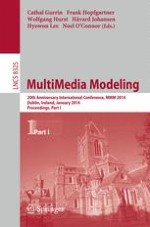The two-volume set LNCS 8325 and 8326 constitutes the thoroughly refereed proceedings of the 20th Anniversary International Conference on Multimedia Modeling, MMM 2014, held in Dublin, Ireland, in January 2014. The 46 revised regular papers, 11 short papers and 9 demonstration papers were carefully reviewed and selected from 176 submissions. 28 special session papers and 6 papers from Video Browser Showdown workshop are also included in the proceedings. The papers included in these two volumes cover a diverse range of topics including: applications of multimedia modelling, interactive retrieval, image and video collections, 3D and augmented reality, temporal analysis of multimedia content, compression and streaming. Special session papers cover the following topics: Mediadrom: artful post-TV scenarios, MM analysis for surveillance video and security applications, 3D multimedia computing and modeling, social geo-media analytics and retrieval, multimedia hyperlinking and retrieval.
